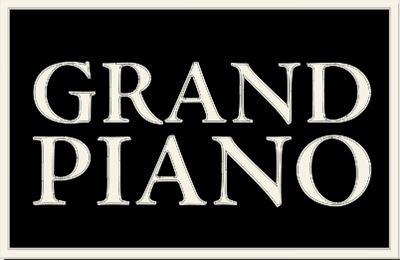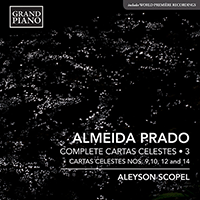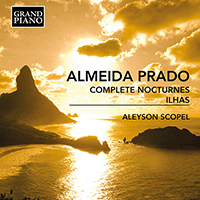
About this Release
“The second volume of my survey of Cartas Celestes features numbers 4, 5 and 6. These were originally intended to be the last ones, as it was not until 15 years later that Prado would go back to the form. Thus, they close a first cycle, painting with sounds the remaining planets from our solar system, including the Earth in all its majesty in Cartas Celestes No. 6, and magically reintroducing all of them as heard in previous volumes in a Ciranda around the Sun. I remain constantly enchanted and intrigued by Prado's soundworld, who kept an innovative, scintillating and spellbinding approach to the instrument, achieving effects not previously thought or heard of.” — Aleyson Scopel
ALMEIDA PRADO, JOSÉ ANTÔNIO REZENDE DE (1943–2010)
Complete Cartas Celestes • 2
Nos. 4–6
- Aleyson Scopel, piano
Cartas Celestes (Celestial Charts) is a colossal 18-movement cycle of works depicting celestial bodies to be seen in the Brazilian sky, for which Almeida Prado, one of Brazil’s most prolific and best-known composers, invented a new harmonic language called “transtonality”. Dense and rhythmically charged and saturated in the richest colours, Nos. 4, 5 and 6 complete the composer’s portrayal of the planets.
This recording was made on a modern instrument: Hamburg Steinway & Sons Concert Grand Model D
Tracklist
|
1
Cartas Celestes No. 4 (1981) (00:30:22)
|
|
2
Cartas Celestes No. 5 (1982) (00:24:03)
|
|
3
Cartas Celestes No. 6 (1982) (00:21:40)
|
The Artist(s)
 Brazilian pianist Aleyson Scopel has performed worldwide in solo, chamber and concerto settings. A recipient of the Nelson Freire and Magda Tagliaferro awards, he has also won numerous prizes in international competitions such as the William Kapell, Villa-Lobos, Corpus Christi, Kingsville and Southern Highland International Piano Competitions. His performance of the first set of Cartas Celestes by Almeida Prado was thus received by the composer: ’It came straight from heaven! Meteor Showers, radiant constellations, glowing nebulae and a transcendental vitality marked the genial interpretation of this colossal pianist.’ Prado would later dedicate to Scopel the 15th set of the series. Aleyson Scopel graduated with distinction in performance and academic honours from the New England Conservatory of Music, in Boston.
Brazilian pianist Aleyson Scopel has performed worldwide in solo, chamber and concerto settings. A recipient of the Nelson Freire and Magda Tagliaferro awards, he has also won numerous prizes in international competitions such as the William Kapell, Villa-Lobos, Corpus Christi, Kingsville and Southern Highland International Piano Competitions. His performance of the first set of Cartas Celestes by Almeida Prado was thus received by the composer: ’It came straight from heaven! Meteor Showers, radiant constellations, glowing nebulae and a transcendental vitality marked the genial interpretation of this colossal pianist.’ Prado would later dedicate to Scopel the 15th set of the series. Aleyson Scopel graduated with distinction in performance and academic honours from the New England Conservatory of Music, in Boston. The Composer(s)
 One of the most prolific composers to emerge from Brazil, José Antônio Rezende de Almeida Prado began as a cultivator of nationalism, studying with Camargo Guarnieri, but as a pupil of Boulanger and Messiaen in Paris was compelled to look for other means of self-expression, attaining a level of aesthetic freedom which encompassed atonalism, post-serialism, extended and free tonalism. Among his most important achievements, referred to by him as an “incredible adventure”, are his 18 Cartas Celestes (Celestial Charts), a set of works depicting the sky and constellations, in which he adopted a new harmonic language called “transtonality”. Of the 18 Cartas Celestes, 15 are written for solo piano, while the remaining three are scored two pianos and symphonic band (No. 7), for violin and orchestra (No. 8) and for piano, marimba and vibraphone (No. 11).
One of the most prolific composers to emerge from Brazil, José Antônio Rezende de Almeida Prado began as a cultivator of nationalism, studying with Camargo Guarnieri, but as a pupil of Boulanger and Messiaen in Paris was compelled to look for other means of self-expression, attaining a level of aesthetic freedom which encompassed atonalism, post-serialism, extended and free tonalism. Among his most important achievements, referred to by him as an “incredible adventure”, are his 18 Cartas Celestes (Celestial Charts), a set of works depicting the sky and constellations, in which he adopted a new harmonic language called “transtonality”. Of the 18 Cartas Celestes, 15 are written for solo piano, while the remaining three are scored two pianos and symphonic band (No. 7), for violin and orchestra (No. 8) and for piano, marimba and vibraphone (No. 11). Reviews
“…Scopel’s pianistic skills are extraordinary but it is primarily his intense identification with this music that makes the performances so great.” – The Art Music Lounge





 Grand Piano has gained a reputation for producing high quality recordings of rare keyboard gems. Dedicated to the exploration of undiscovered piano repertoire, the label specialises in complete cycles of piano works by many lesser-known composers, whose output might otherwise have remained unknown and unrecorded.
Grand Piano has gained a reputation for producing high quality recordings of rare keyboard gems. Dedicated to the exploration of undiscovered piano repertoire, the label specialises in complete cycles of piano works by many lesser-known composers, whose output might otherwise have remained unknown and unrecorded.






